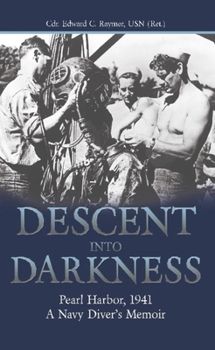Descent Into Darkness: Pearl Harbor, 1941: A Navy Diver's Memoir
Select Format
Select Condition 
Book Overview
On December 7, 1941, as the great battleships Arizona, Oklahoma, and Utah lie paralyzed and burning in the aftermath of the Japanese ttack on Pearl Harbor, a crack team of U.S. Navy salvage divers headed by Edward C. Raymer are hurriedly flown to Oahu from the mainland. The divers have been given a Herculean task: rescue the sailors and Marines trapped below, and resurrect the pride of the Pacific fleet. Now for the first time, the chief diver of the Pearl Harbor salvage operations, Cmdr. Edward C. Raymer, USN (Ret.), tells the whole story of the desperate attempts to save crewmembers caught inside their sinking ships. Descent into Darkness is the only book available that describes the raising and salvage operations of sunken battleships following the December 7th attack. Once Raymer and his crew of divers entered the interiors of the sunken shipwrecks--attempting untested and potentially deadly diving techniques--they experienced a world of total blackness, unable to see even the faceplates of their helmets. By memorizing the ships' blueprints and using their sense of touch, the divers groped their way hundreds of feet inside the sunken vessels to make repairs and salvage vital war material. The divers learned how to cope with such unseen dangers as falling objects, sharks, the eerie presence of floating human bodies, and the constant threat of Japanese attacks from above. Though many of these divers were killed or seriously injured during the wartime salvage operations, on the whole they had great success performing what seemed to be impossible jobs. Among their credits, Raymer's crew raised the sunken battleships West Virginia, Nevada, and California. After Pearl Harbor they moved on to other crucial salvage work off Guadalcanal and the sites of other great sea battles.
Format:Paperback
Language:English
ISBN:1591147247
ISBN13:9781591147244
Release Date:March 2012
Publisher:Naval Institute Press
Length:240 Pages
Weight:0.74 lbs.
Dimensions:0.6" x 5.2" x 8.3"
Customer Reviews
5 ratings
descent into darkness
Published by Thriftbooks.com User , 18 years ago
what a great book! i couldn't put it down. commander raymer and the men working with him were brave heroes.this book gives a glimpse of life in hawaii in the early forties as well as the navy's diving program in its infancy.not to mention the unique problems of salvaging the ships that were damaged in the pearl harbor attack.i highly recommend this book.
History written by a eyewitness
Published by Thriftbooks.com User , 20 years ago
This really is a first-rate account of a process that has largely been ignored by writers and historians. I think it's a "given" that diving around sunken, fully armed and fueled battleships would be dangerous, but until I read this book I didn't realize just how MANY different hazards there were. For example, who would have known that it's dangerous to enter a previously-sealed but empty compartment that contains rust? (the formation of iron oxide [rust] depletes oxygen in the space)The reader gets a firsthand account of the daily lives of salvage divers, and how frequently solutions to problems were devised on the spot. Rather unexpectedly, readers also get a firsthand description of what life was like "on the ground" during the Guadalcanal campaign.Anyone wanting to know more about the Pearl Harbor attack really should read this book. Many people tend to think of the battle as being over when the last Japanese plane returned to its carrier; in truth, the battle had just BEGUN.
A females take on the other side of the war effort..
Published by Thriftbooks.com User , 23 years ago
I have limited knowledge about the attack on Pearl Harbor from history books and documentaries, and wanted a new point of view to read to prepare myself for the epic movie "Pearl Harbor" coming out Memorial Day 2001. Needless to say, I could not put the book down. The book was written so easily for a layperson unfamiliar with ship repair, salvage efforts and the work the men on the back line, so to speak, to understand the techniques and personal fear and strength that these divers endured. Shocking visuals, heart break of death, pride in work, commitment to the job, danger and opportunity for technique advancement all are described so well by the author.
Excellent view of a working enlisted diver.
Published by Thriftbooks.com User , 24 years ago
As a military diver I could easily identify with the techniques and characters in the book. While the techniques have been updated, the people haven't really changed. This book shows what life was/is like for a diver. Divers often work in extremely nasty environments with little to no visibility. Add to this the psychological effects of being among different things that you must identify by feel and you get a small glimpse of what it is like. This type of diving is completely different from civilian SCUBA and this illustrates the type of mentality required. This book will show you what it is like to really be a working diver. All present and former divers owe a tremendous debt to gentlemen like Mr Raymer. They were truly pioneers whose accomplishments often went unreported and unrecognized.
Important historical account of diving safety development.
Published by Thriftbooks.com User , 25 years ago
As a retired US Navy Diver, I enjoyed Commander Raymer's account of how various salvage and diving safety techniques were developed during the salvage of the battleships at Pearl Harbor. Many of the procedures that these Bubbleheads thought up in their off hours became standards taught to deepsea divers thirty years later. This story of a great diving adventure is a must read for all divers whether they be military, commercial, or recreational.





